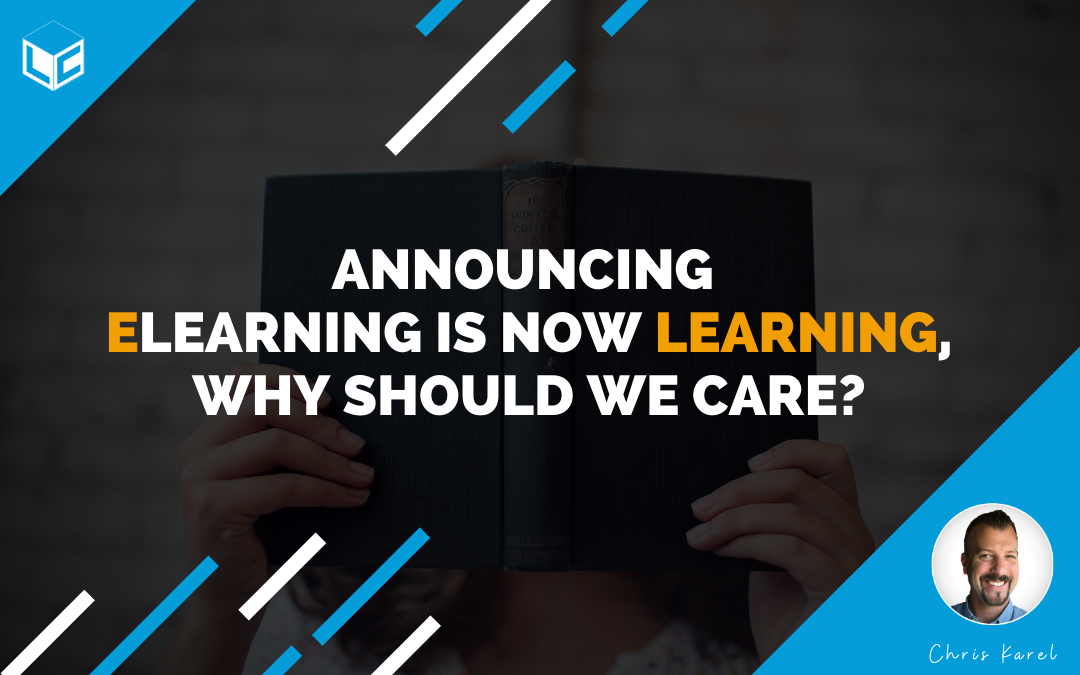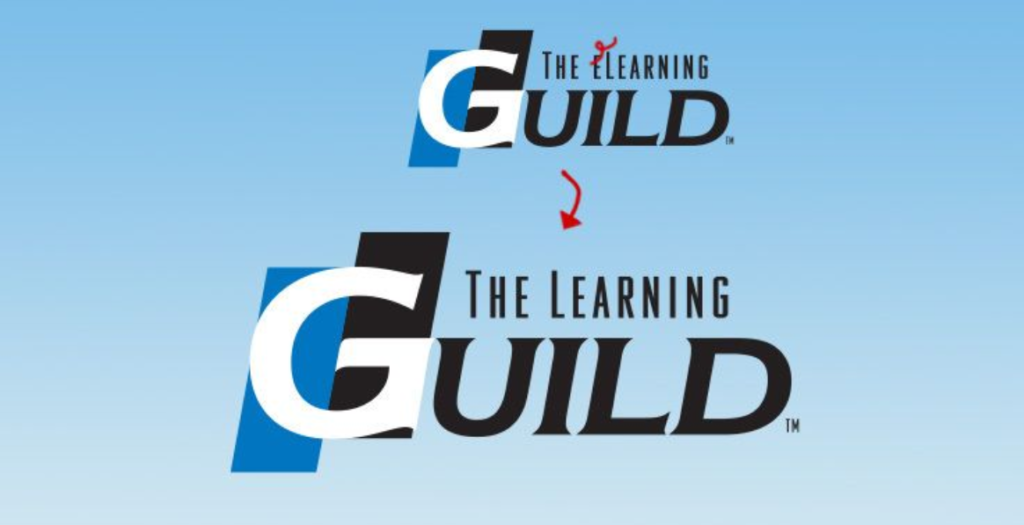I’m on a mission to help people make and use video for learning purposes. Notice I didn’t say “e” learning purposes. Current times, a.k.a the new normal, has seen a spike in Google searches for “eLearning.” I prefer the term learning, which is why my video consulting and learning development company is called Learning Carton. This month, a major player in the L & D industry, eLearning Guild, took a literal step away from the “e” to define itself. The new moniker is more inclusive as eLearning is remote, sometimes in-person, and even live online. I’m stoked at this new direction.
So let’s get to it!
“What do you want to be when you grow up?”
“An eLearning Specialist!”
…said no kid ever.
Announcing…eLearning is Now Learning. Why Should We Care?
According to Google Trends, between March 15-21 of 2020, the term “eLearning” reached 100% peak popularity. Overnight, working and learning became remote activities. Billions of people Googled the term for answers. To my friends and family, the term eLearning meant learning online and remotely. Some even said, “Well, if the kids can’t be in a classroom, then they are doing eLearning.” The term certainly has new connotations, and I for one am excited that it is evolving. So, let’s try and see if we can define it.

eLearning Defined
Schools and businesses use eLearning. Education helps students learn knowledge, skills, and behaviors so they may pursue work and understand how to function successfully in society. I’m simplifying education’s purpose here – please stay with me. Training helps improve knowledge, skills, and behaviors, but training’s ultimate goal is to serve a business purpose.
It’s important to keep the purpose of education v. training in mind as I share how the two “learning” entities define eLearning. Let’s start with the dictionaries.
The Cambridge Dictionary defines eLearning as, “Learning done by studying at home using computers and courses provided on the internet.” Clearly, they are thinking solely of education.
Lexico, powered by the Oxford dictionary, defines it as, “Learning conducted via electronic media, typically on the Internet.” A broader definition than Cambridge, the Oxford dictionary’s definition applies to education or training.
Dictionary.com defines eLearning as, “Distance learning; computer-based learning.”
Merriam-Webster dictionary doesn’t even have an entry for eLearning, so poo-poo to them.
I shared these five dictionary references to make a point: we don’t have a single definition for eLearning. As a learning professional, I believe simple is better. eLearning equals electronic learning. In other words, if you are using electronic technology to learn something, then that is eLearning. If you are relying on paper books or live instruction then you are not doing eLearning. Let’s look at how the two worlds – education and training – define the term.

Corporate Training (Learning)
The atd (Association for Talent Development), the largest global organization devoted to empowering professionals to develop talent in the workplace, defines eLearning for the corporate training world:
What Is E-learning?
E-learning is a structured course or learning experience delivered electronically; it can also include performance support content. There are also many different elements that can make up an e-learning program, such as live or pre-recorded lecture content, video, quizzes, simulations, games, activities, and other interactive elements.
Keep in mind that you may also see the term e-learning more broadly as a catchall for any learning content delivered electronically. While ATD style uses a hyphen in the spelling, you may also see it spelled elearning or eLearning.
The popularity of e-learning continues to rise. According to ATD’s 2018 State of the Industry report, e-learning accounted for nearly 40 percent of formal learning hours used in 2017.
K-12 & Higher Education
eLearning North Carolina offers the featured definition of eLearning on Google. I suppose this has a lot to do with their domain name, but their definition does correlate more to education than it does to corporate learning.
What is eLearning?
Understanding eLearning is simple. eLearning is learning utilizing electronic technologies to access educational curriculum outside of a traditional classroom. In most cases, it refers to a course, program or degree delivered completely online.
There are many terms used to describe learning that is delivered online, via the internet, ranging from Distance Education, to computerized electronic learning, online learning, internet learning and many others. We define eLearning as courses that are specifically delivered via the internet to somewhere other than the classroom where the professor is teaching.
It is not a course delivered via a DVD or CD-ROM, video tape or over a television channel. It is interactive in that you can also communicate with your teachers, professors or other students in your class. Sometimes it is delivered live, where you can “electronically” raise your hand and interact in real time and sometimes it is a lecture that has been pre-recorded.
There is always a teacher or professor interacting /communicating with you and grading your participation, your assignments and your tests. eLearning has been proven to be a successful method of training and education is becoming a way of life for many citizens in North Carolina.
I am a trained teacher with a Master of Education. Now I create corporate training and help people make a video for learning purposes. So, I firmly believe both definitions have merit. After all, language is living and shapes the way we think, as Lera Boroditsky stated in her aptly titled Ted talk.
Words are not like numerals which hold the same meaning today as they did 100 years ago. Ever since “eLearning” peaked on Google, we humans have been shaping the term to be a part of our normal vocabulary. Some argue we should drop the “e” altogether because learning is learning.
eLearning Guild Drops the “e”
A mainstay in the learning and development industry changed its name on May 7th, 2020.
The eLearning Guild is now the Learning Guild:
The eLearning Guild, a global community of practice for learning professionals, announced a major rebranding today, changing its name to The Learning Guild. The change reflects the evolution of the learning technologies industry and better positions it to meet the needs of the growing community it serves (Read the full article on Learning Solutions).
Now that’s what I call language shaping the way we think! The Guild, known for the well-respected Learning Solutions publication, the DevLearn conference, and their notable webinar series, is effectively shaping the way we think about the word, “eLearning.”
I’m psyched they are making this change because it aligns with how I see education and training – two worlds with learning at their core. Technology is just a tool. David Kelly, executive director of The Learning Guild, supports my position: “Learning facilitated by digital tools, content, and interactivity no longer describes just eLearning; it describes how we support all learning.”
Summary
If we view eLearning broadly then we can allow it to evolve. A narrow eLearning definition may lead to more click-next-to-continue, and poorly made visuals. Remember the imaginary kid in my quote above? He or She didn’t really want to grow up to be an eLearning Specialist. But she or he may want to grow up to be a teacher or a corporate learning expert. Until our little ones become old enough to take over, it is up to us to shape the “learning” industry. Thanks to the leadership of the Guild, we can embrace what’s next. I know I’m ready for it.
I’m ready to drop the “e.”
Our new normal depends upon it.
Helpful Links
Are you looking to make a course or get help for your people who make courses for you? Consider these helpful links on pricing and process.
Guide to Custom eLearning Costs
Rapid Online eLearning Planner
Share your voice with me
Do you think we should drop the “e” in eLearning?
Did you like what you read? Join my learning pals. Please subscribe to my newsletter to receive free learning resources delivered to your inbox every two weeks.
THE END



